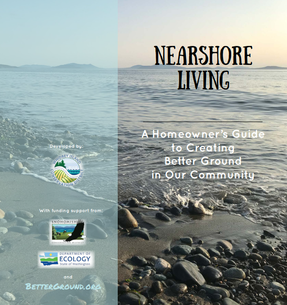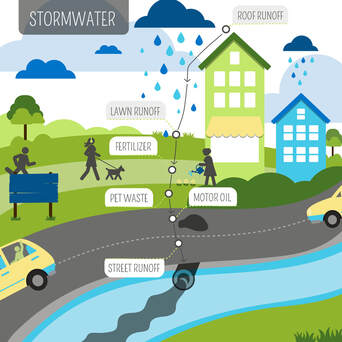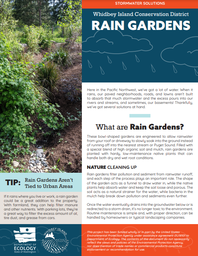Water Resource Management
|
Water resource management is of paramount importance to agriculture and urban communities on Whidbey Island. We all use water and we all live downstream. The availability of safe drinking water, groundwater & aquifer recharge, and safely discharged stormwater are critically important to the residents of Whidbey Island.
Perhaps water resource management for you involves drainage challenges, erosion, an excess of water, steep slope stabilization, or alternative stormwater management techniques. Request Assistance below and check out our Resource Hub. Note that our planners are able to supply you with high level resources and guidance, but if your request involves sheer or steep bluffs that require the expertise of an engineer, we encourage you to consult a geotechnical engineer: Skagit Island Buildings Association Professionals Directory, Puget Sound Engineering Council, American Society of Civil Engineers Seattle Section Geotechnical Group, and Structural Engineers Association of Washington. 
Nearshore Living
Orcas swim by, herons stand patiently waiting for fish, clams and mussels hide in the sand until our shovels dig them up. We eat and recreate in the ocean, lakes, and rivers. We get our drinking water from underground aquifers and nearby rivers. And we share our world with many other creatures who call the oceans and rivers their home. As island residents, we live on the nearshore - that magical place where land meets ocean. It's our responsibility to be good stewards of our place and Whidbey Island Conservation District is here to help! |
TIPS for Common QuestionsStormwater & DrainageOur Islands, Our Water, Our Future
A local guide on water management, including septic, stormwater, lawn care Tulalip Tribes: Rainwater Management Learn to assess your property and potential best management practices Rain Garden Handbook of WA Learn all about designing, installing, and maintaining a rain garden Solving Drainage & Erosion Guide Learn about solving specific drainage and water resource challenges WetlandsAt Home with Wetlands Guide
Got a wetland on your property and interested in stewarding it? Wetland Plant Care Tips Learn about installing and maintaining plants best suited for wetlands ShorelineBetter Ground Shorelines
Helpful FAQ from our Puget Sound Conservation Districts hub Guide to Shoreline Living by the WSU Extension Island County Shore Stewards Program Your Marine Waterfront Native plant selection for shorelines, and other best management practices BLUFFSThese comprehensive guides from WA Department of Ecology will help you with your bluff property Surface & Ground Water Vegetation Management Slope Stabilization & Erosion Control |
Stormwater and Rain Gardens
View the extended Stormwater Steward series on our Youtube Playlist
This project has been funded wholly or in part by the United States Environmental Protection Agency under assistance agreement 01J18101 to Department of Ecology.
The contents of this document do not necessarily reflect the views and policies of the Environmental Protection Agency, nor does mention of trade names or commercial products constitute endorsement or recommendation for use.
This project has been funded wholly or in part by the United States Environmental Protection Agency under assistance agreement 01J18101 to Department of Ecology.
The contents of this document do not necessarily reflect the views and policies of the Environmental Protection Agency, nor does mention of trade names or commercial products constitute endorsement or recommendation for use.

Let's Talk About Stormwater
Stormwater is the name we use for rain and snow when it hits the ground. In a natural system, this water would fall on plants and healthy soil. The plants would absorb some of the water and the soil would retain and filter some of the water to be released slowly into waterways. Some of the water would make a long journey down to refresh our underground aquifers, which is where most Whidbey residents get their drinking water. But in our human developments, there's a lot of surface area that can't absorb water (impermeable surfaces), such as streets, parking areas, sports fields, gravel lots, rooftops, and driveways. What happens to that stormwater?
Stormwater is the name we use for rain and snow when it hits the ground. In a natural system, this water would fall on plants and healthy soil. The plants would absorb some of the water and the soil would retain and filter some of the water to be released slowly into waterways. Some of the water would make a long journey down to refresh our underground aquifers, which is where most Whidbey residents get their drinking water. But in our human developments, there's a lot of surface area that can't absorb water (impermeable surfaces), such as streets, parking areas, sports fields, gravel lots, rooftops, and driveways. What happens to that stormwater?

Stormwater Run-off is rain that falls on impermeable surfaces and, since it can't be absorbed by these surfaces, it flows directly into nearby lakes, rivers and Puget Sound. For us islanders who live on the near-shore, the ocean is never far away, and our stormwater run-off flows into it with few opportunities to be caught and filtered. Everything that sits on our roofs, driveways, sidewalks, and streets is in danger of being picked up by stormwater run-off and carried to the ocean along with the water. As landowners, our job is to keep impermeable surfaces free of pollutants, fecal bacteria, and garden chemicals so that these pollutants don't build up in our waterways and poison them. Rain gardens are a wonderful, low maintenance solution to treating run-off in any landscape.
